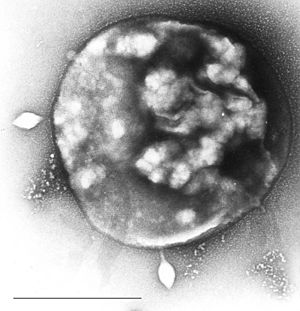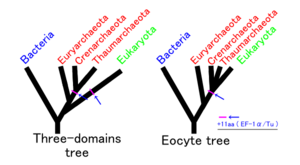Crenarchaeota facts for kids
Quick facts for kids Crenarchaeota |
|
|---|---|
 |
|
| Archaea Sulfolobus infected with specific virus STSV-1. | |
| Scientific classification | |
| Domain: | |
| Kingdom: |
Proteoarchaeota
|
| Superphylum: |
TACK
|
| Phylum: |
"Crenarchaeota"
Garrity & Holt 2002
|
| Class | |
|
|
| Synonyms | |
|
|
The Crenarchaeota (say: KREN-ar-kee-OH-tuh) are a special group of tiny living things called Archaea. They are so small you need a microscope to see them! Scientists first thought these archaea only lived in very hot places, like hot springs or near volcanoes, and needed sulfur to survive. They are known as extremophiles because they love extreme conditions.
But guess what? Newer studies have found Crenarchaeota almost everywhere! They are especially common in the ocean. In fact, they might be the most common archaea in the sea. This means they are super important for life on Earth, even if we can't see them.
Contents
What are Crenarchaeota?
Crenarchaeota are a major group within the Archaea. They were first identified because their RNA (a bit like DNA) sequences were different from other archaea. Most Crenarchaeota don't have histones, which are special proteins that help organize DNA in other living things. However, some Crenarchaeota do have histones.
Where do they live?
Many Crenarchaeota love heat! They are called thermophilic (heat-loving) or hyperthermophilic (super heat-loving) organisms. Some can even grow in temperatures up to 113 °C (235 °F), which is hotter than boiling water!
These tiny organisms are also very diverse in shape. Some look like rods, others are round (called cocci), and some are long and thin (called filamentous). They are also Gram-negative, which is a way scientists classify bacteria and archaea based on their cell walls.
Sulfolobus: A Famous Crenarchaeota
One of the most well-known Crenarchaeota is a type called Sulfolobus solfataricus. This organism was first found in hot, sulfuric springs in Italy. It thrives in very hot water (around 80 °C or 176 °F) and in very acidic conditions (like lemon juice, with a pH of 2–4).
Why is Sulfolobus special?
Sulfolobus is important because it's easier to study in a lab than many other heat-loving microbes. Unlike most, Sulfolobus grows aerobically, meaning it uses oxygen. It's also a chemoorganotroph, which means it gets its energy from breaking down organic stuff, like sugars.
Because it's easier to grow, Sulfolobus has become a "model organism." This means scientists use it a lot to learn about organisms that live in extreme heat. They also study the many different viruses that infect Sulfolobus.
Crenarchaeota in the Ocean
Since 1992, scientists have found signs of Crenarchaeota genes in marine (ocean) environments. This was a big surprise because they thought these organisms only lived in hot places!
Low-temperature Crenarchaeota
Scientists have studied special fats, called lipids, from the cell membranes of Crenarchaeota found in the open ocean. These lipids show that "low temperature Crenarchaeota" are very common in the sea. They are thought to play a huge role in carbon fixation, which is how living things turn carbon dioxide into organic matter. This is a key part of Earth's carbon cycle.
Crenarchaeota DNA has also been found in soil and freshwater. This suggests that these tiny organisms are found almost everywhere on Earth!
In 2005, scientists finally managed to grow a "low temperature Crenarchaeota" in the lab. It was named Nitrosopumilus maritimus. This organism was found in a marine aquarium and grows at a much cooler temperature of 28 °C (82 °F). It's an ammonia-oxidizing organism, meaning it uses ammonia for energy.
The Eocyte Hypothesis
The eocyte hypothesis is a scientific idea from the 1980s. It suggests that eukaryotes (living things with complex cells, like plants, animals, and fungi) might have evolved from a type of prokaryotic eocyte, which is another name for Crenarchaeota.
One piece of evidence for this idea is that Crenarchaeota have a special protein called Rbp-8, which is similar to a part of the RNA polymerase found in eukaryotes. Other archaea, called Euryarchaea, don't have this protein. This similarity suggests a close link between Crenarchaeota and eukaryotes.
See also
 In Spanish: Thermoproteia para niños
In Spanish: Thermoproteia para niños


